Continue reading for our analysis...
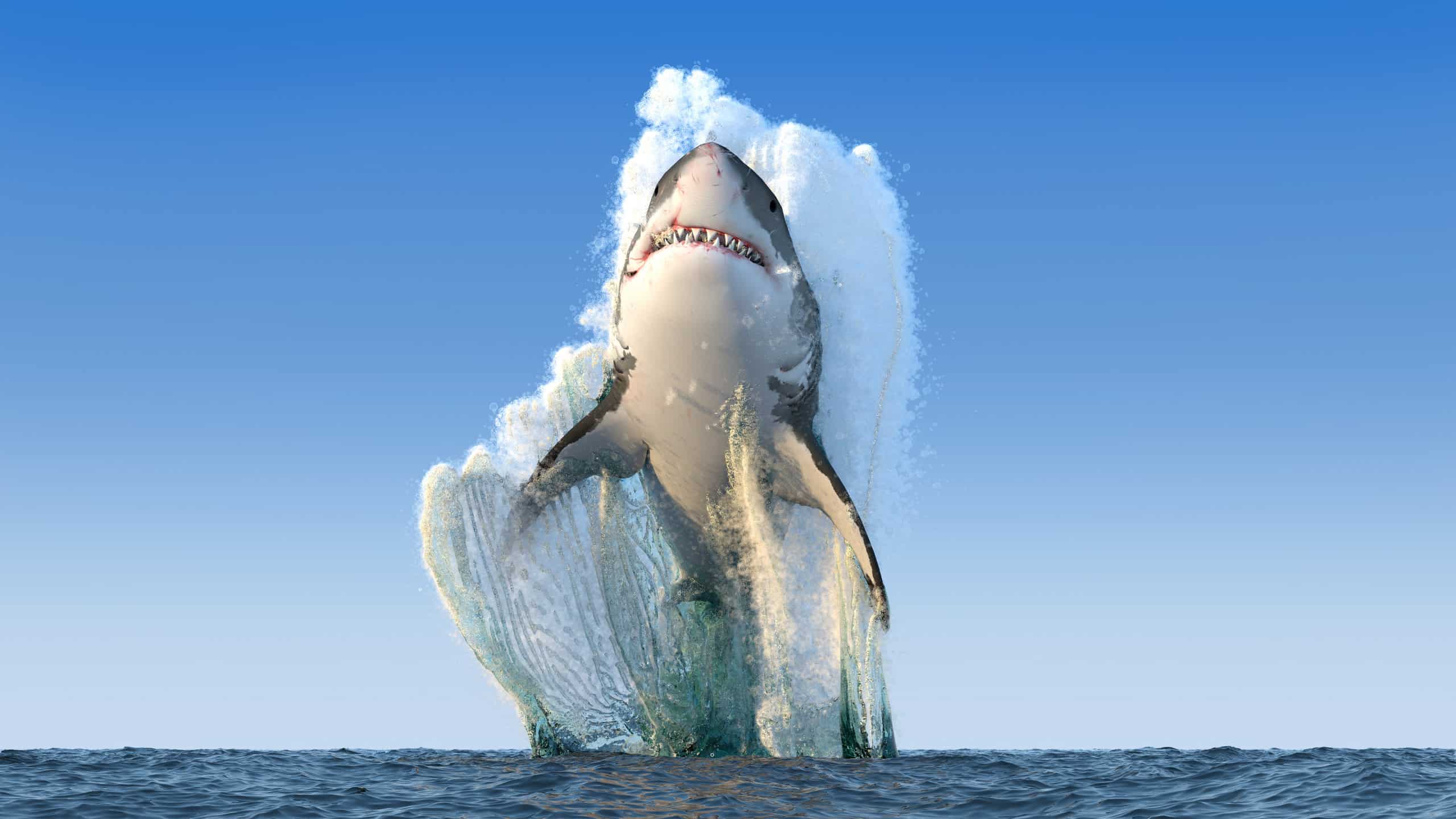
The great white shark is the largest predatory fish known to man. It doesn’t chew its food despite having 300 teeth. Sharks consume their prey whole after tearing it into pieces the size of their mouths. The shark can travel effectively for extended periods of time thanks to its hefty, torpedo-shaped body, and then abruptly convert to high-speed spurts in pursuit of prey, occasionally jumping out of the water.

Sharks are often curious about boats and can be found swimming underneath or circling around them.
©Willyam Bradberry/Shutterstock.com
The whale shark, which can grow to a length of 46 feet, is the largest shark. The average length of a female great white shark is 15 to 21 feet, whereas a male measures 11 to 13 feet. On average, a great white weighs between 1,500 and 2,400 pounds, although it can reach up to 5,000 pounds.
A Close Encounter
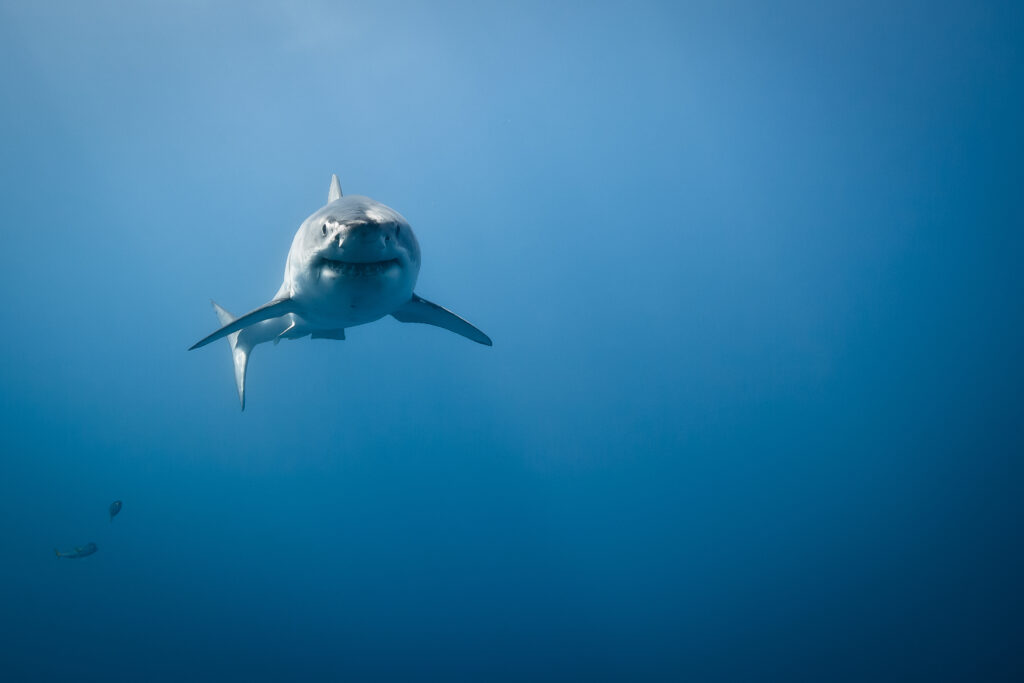
Great white sharks can weigh as much as 5,000 pounds, although half that size is more common.
©iStock.com/vladoskan
The people in this YouTube Short claim they believe the giant shark they encounter is 30 feet long! If they’re right, they’ve just met the longest-great white in the world. So far, research shows a famous white shark called Deep Blue as holding the title for the largest great white.
20 feet long, 8 feet wide, and 2.5 tons in weight — that’s Deep Blue. Although Deep Blue had been the subject of rumors since the 1990s, it wasn’t until 2014 that researcher Mauricio Hoyos Padilla managed to capture footage of her during a segment of Shark Week off the coast of Guadalupe Island in Mexico. In 2015, Padilla uploaded a video of her to Facebook, and it quickly became popular.
Where Do Great White Sharks Live?
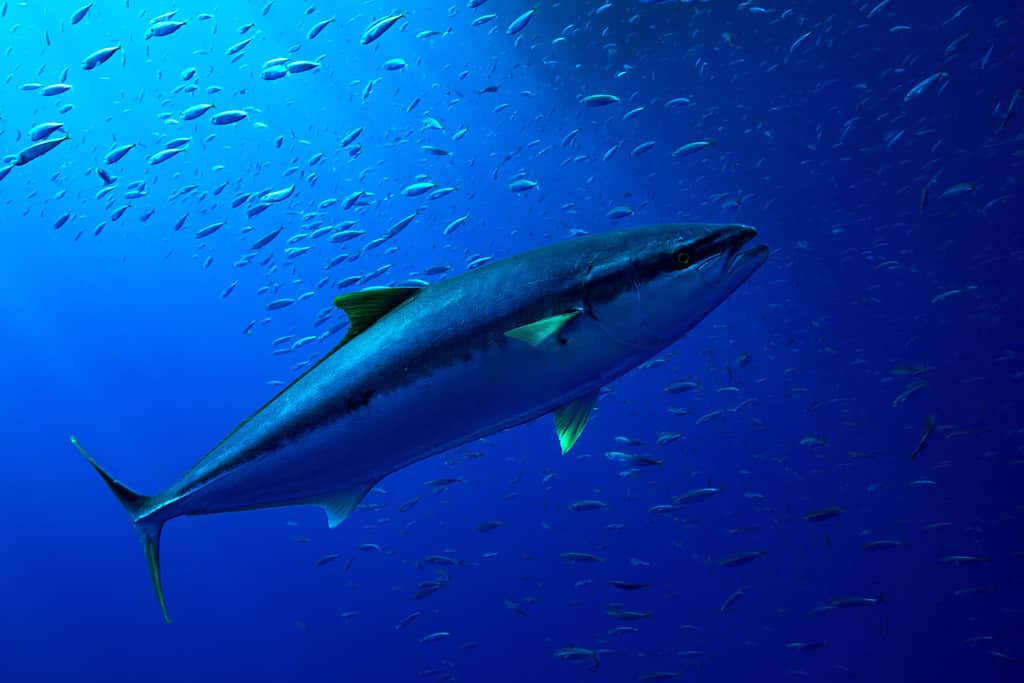
Great white sharks eat many types of fish, including tuna.
©J nel/Shutterstock.com
White shark communities are commonly concentrated in highly productive temperate coastal waters, which are defined as having a large number of fish and marine mammals. Examples of these waters include those off the coasts of the northeastern and western United States, Chile, southern Australia, and New Zealand.
The biggest populations of great whites are located in South Africa, off the coast of Dyer Island, which has been dubbed “shark alley.” The only areas in the world that great white sharks aren’t commonly found in are the polar regions, notably the Arctic and Southern Oceans.
Although some white sharks may venture into tropical or far-off waters on their own, field research reveals that the majority of them return to their moderate feeding grounds every year. Sharks come in a variety of species, with sizes ranging from smaller than a person’s hand to larger than a bus.
Is it Normal for Sharks to Circle Boats?
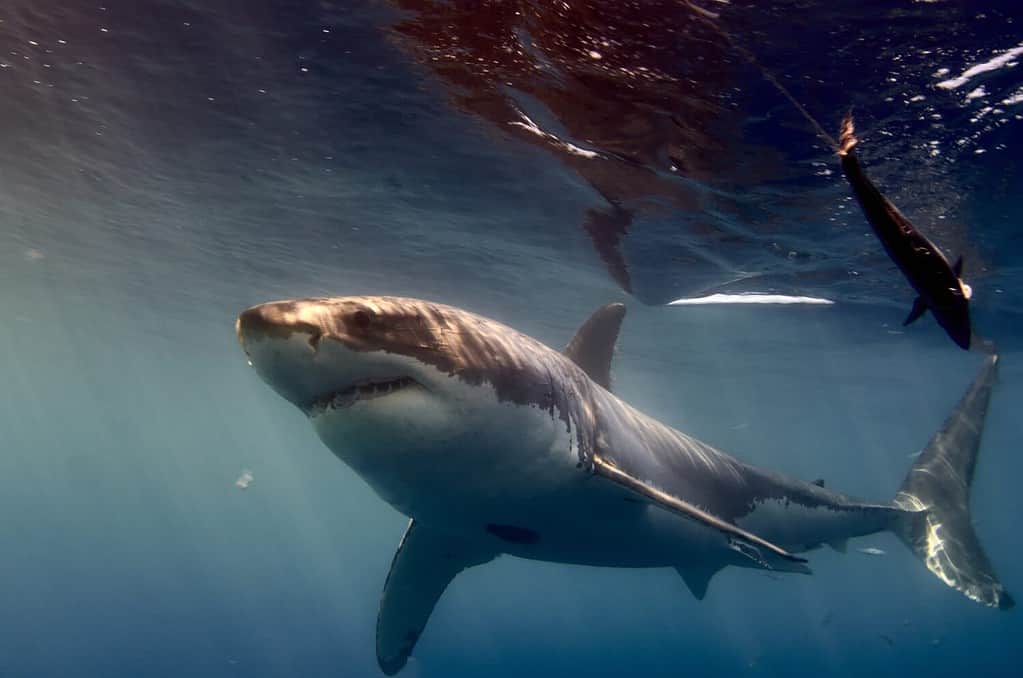
The great white shark is the largest predatory fish on earth, but it would rather eat fish than humans.
©Wirestock Creators/Shutterstock.com
It is normal for sharks to circle and swim near boats. Sharks don’t circle in the water before they strike. The reason for this circling behavior is based on curiosity rather than feeding or hunting for prey.
Typically, sand tiger sharks are known for gravitating to and near shipwrecks as a place to feed on fish. Although sharks like abandoned shipwrecks, it is generally normal behavior for sharks to circle boats or ships to understand what they are.
What Do Great White Sharks Eat?
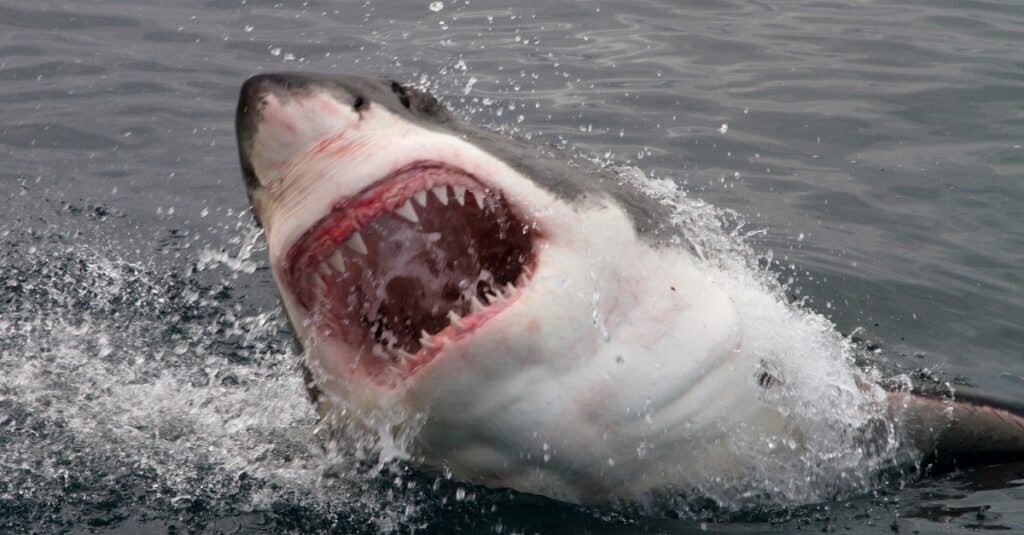
Although shark attacks do happen, scientists believe that sharks often mistake humans for seals.
©iStock.com/Peter_Nile
Great whites are carnivores, and their diet mostly consists of seals and sea lions. In the event a shark attacks a human, it’s thought to be because they mistook the person for a seal, and they usually retreat after the first bite.
Other items on the menu for great whites are dolphins, porpoises, beaked whales, tuna, mackerel, and seabirds. Discover what else great white sharks eat here.
How Long Do Great White Sharks Live?

Starting as a tiny embryo and ending as a 5,000 animal, sharks live for 50 years or more.
©Daniel Majak/Shutterstock.com
On average, a great white shark will live between 40 to 70 years. Up until recently, it was believed a great white’s lifespan was 25 to 30 years. However, in 2014, researchers found they grow more slowly and live longer than that, concluding white sharks in the western North Atlantic Ocean can survive for about 73 years.
As it can take up to 15 years for a shark to be considered fully grown, there are many sharks that die before reaching adulthood.
Threats to great whites include overfishing by humans, destruction of their habitat, and killer whales.
Great White Sharks vs. Killer Whales
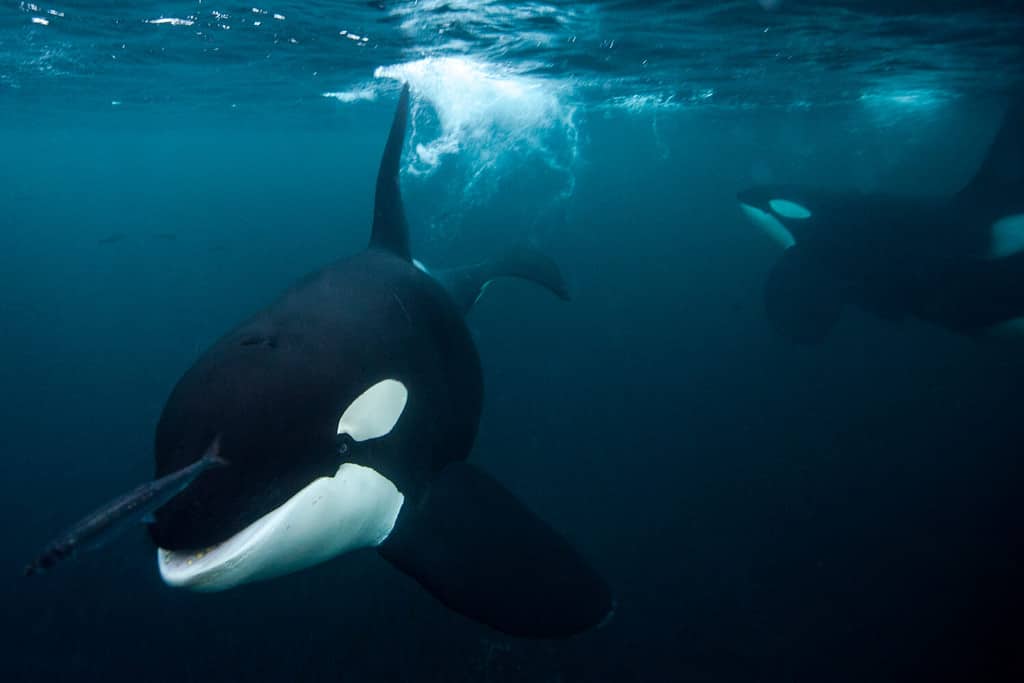
Orcas weigh anywhere from 6,000 pounds to 15,000 pounds.
©Petr Slezak/Shutterstock.com
While great white sharks are a danger to many animals, there is a more powerful apex predator that is a threat to them: the killer whale. Also called orcas, killer whales have the advantage over great whites when it comes to size and their defensive and offensive capabilities.
Killer whales are much larger and longer than great white sharks. They can weigh from 6,000 pounds to a whopping 15,000 pounds and stretch from 16 to 26 feet long.
Killer whales also have better defenses, including a bite force that’s almost five times that of a great white shark and heightened hearing that helps them find prey and avoid predators. They have a thick layer of blubber that protects their bodies and a tail that they use to swat prey. Plus, they can count on safety in numbers since killer whales live in pods consisting of 10 to 20 orcas, while great whites are lone sharks or hunt in pairs.
However, great white sharks are faster than killer whales and can hit a top speed of 35 mph, and they have incredible predatory senses that enable them to locate food based on smell, taste, hearing, and electromagnetism.
So the big question is: Which would win in a fight: a great white shark or a killer whale?
A killer whale would likely win when faced with a great white. The only case in which an orca could possibly be injured or killed is in the event that the biggest great white took on the smallest orca. You can read more about what might happen in an epic battle between Deep Blue and a killer whale here.
No matter what shark these ocean-goers came across in this YouTube Short there’s no denying that it was huge! As the video starts, you can’t even tell there’s a shark in the water. It gets so close to the surface that its fin comes above water temporarily. It’s safe to say this great white is hungry and thankfully didn’t snack on any humans that day!
What would you do if you came this close to one of the world’s greatest apex predators? Take a look at the YouTube Short below and other close calls with these ocean mammoths below!
How Large Are Adult Great Whites?

The largest great white on record is Deep Blue, who is over 20 feet long and weighs an estimated 2.5 tons.
©iStock.com/Martin Heyn
The largest great white shark can reach lengths of up to 20 feet, although the majority are smaller than this. Females are generally larger than males, with the average size of a female great white shark reaching between 15-16 feet, and the average size of a male reaching between 11-13 feet. The largest great white on record is Deep Blue, who is over 20 feet long and weighs an estimated 2.5 tons.
Thank you for reading! Have some feedback for us? Contact the AZ Animals editorial team.







